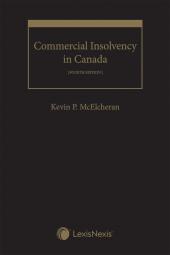Commercial Insolvency in Canada, 4th Edition – Student Edition
**This title is to be purchased by students only**
This new edition of Commercial Insolvency in Canada provides a comprehensive examination of Canada's insolvency laws and related jurisprudence to help lawyers navigate the evolving legal landscape. This is a student edition.
One Year Subscription Only Terms
Subscribers receive the product(s) listed on the Order Form and any Updates made available during the annual subscription period. Shipping and handling fees are not included in the annual price.
Subscribers are advised of the number of Updates that were made to the particular publication the prior year. The number of Updates may vary due to developments in the law and other publishing issues, but subscribers may use this as a rough estimate of future shipments. Subscribers may call Customer Support at 800-833-9844 for additional information.
Subscribers may cancel this subscription by: calling Customer Support at 800-833-9844; emailing customer.support@lexisnexis.com; or returning the invoice marked 'CANCEL'.
If subscribers cancel within 30 days after the product is ordered or received and return the product at their expense, then they will receive a full credit of the price for the annual subscription.
If subscribers cancel between 31 and 60 days after the invoice date and return the product at their expense, then they will receive a 5/6th credit of the price for the annual subscription. No credit will be given for cancellations more than 60 days after the invoice date. To receive any credit, subscriber must return all product(s) shipped during the year at their expense within the applicable cancellation period listed above.
Détails des produits
**This title is to be purchased by students only**
Click here for the professional edition of Commercial Insolvency in Canada, 4th Edition.
In the opening chapter of the latest edition of Commercial Insolvency in Canada, author and insolvency expert Kevin McElcheran sets the stage for the content of the rest of the book: “Each of the many stakeholders affected by the insolvency of a business enterprise [from creditors and employees, to landlords, suppliers and shareholders] may seek to invoke their various legal remedies to achieve a resolution of the business problem of insolvency in accordance with their best interests from their perspective.” As he goes on to explain, our legal system attempts to address the ensuing conflicts “through the patchwork of statute and case law that is Canadian commercial insolvency law.”
Throughout this treatise, McElcheran strives to focus on insolvency as a whole – rather than discussing the patches in isolation, he describes the overall state of the quilt.
Comprehensive content
This fourth edition of Commercial Insolvency in Canada continues the practical approach of earlier versions and proceeds from the basic premise that all persons interested in or affected by commercial insolvency are entitled to be treated with respect in the insolvency process and are entitled to participate in the process effectively to pursue their legitimate interests.
The first two chapters of the book form the basis of discussion of the position of each group of constituents of the insolvent debtor that follows in subsequent chapters. In the final chapter, readers will find an outline of Canada’s version of the UNCITRAL Model Law for recognizing and giving effect to foreign insolvency proceedings in Canada as well as an analysis of cross-border restructuring proceedings based in Canada.
Updates in this latest edition include:
- A discussion of the most recent developments in the relevant case law
- A revised, practical table of cases and detailed index
- Content that reflects the amendments to the Bankruptcy and Insolvency Act and the Companies’ Creditors Arrangement Act (CCAA) that were passed in June 2019. The effect of these changes will be to restrict the scope of Initial Orders made under the CCAA and impose new director liabilities for payments made to compensate managers of insolvent businesses
- Revisions to Chapter 2 that address the distribution among stakeholders of the value in businesses preserved in the insolvency process and that follow developments that further constrict the scope of claims that can be compromised or eliminated through the restructuring process
A Practical Acquisition
Commercial Insolvency in Canada, 4th Edition is an invaluable resource that will be particularly relevant to:
- Corporate/commercial lawyers who advise businesses facing bankruptcy or insolvency issues
- In-house counsel at a company facing bankruptcy or insolvency issues
- Lenders, insolvency, restructuring and turnaround professionals, and distressed debt investors who require an informational resource to assist with navigating day-to-day issues affecting clients
- Law libraries who want to provide comprehensive research resources for their patrons
Table des matières
Chapter 1: Introduction – Insolvency is a Business Problem
Chapter 2: Claims, Priorities and Performance
Chapter 3: Rights and Remedies of Unsecured Creditors
Chapter 4: Rights and Remedies of Secured Creditors
Chapter 5: Commercial Reorganization
Chapter 6: The Role of Directors and Officers in the Restructuring Process
Chapter 7: Cross-Border Insolvencies
Produits liés
-
 Commercial Insolvency in Canada, 4th EditionDate de sortie: November 14, 2019335,00 $
Commercial Insolvency in Canada, 4th EditionDate de sortie: November 14, 2019335,00 $ -
 Code criminel et lois connexes annotés, édition 2025 (Volume 1) + Guide du praticien (Volume 2) + Livre électroniqueDate de sortie: August 13, 2024175,00 $
Code criminel et lois connexes annotés, édition 2025 (Volume 1) + Guide du praticien (Volume 2) + Livre électroniqueDate de sortie: August 13, 2024175,00 $ -
 Méthodologie et épistémologie du droit comparé : Diverses méthodes et écolesDate de sortie: July 10, 2024100,00 $
Méthodologie et épistémologie du droit comparé : Diverses méthodes et écolesDate de sortie: July 10, 2024100,00 $
 Lexis Nexis
Lexis Nexis 